-
Paper Information
- Paper Submission
-
Journal Information
- About This Journal
- Editorial Board
- Current Issue
- Archive
- Author Guidelines
- Contact Us
Management
p-ISSN: 2162-9374 e-ISSN: 2162-8416
2014; 4(2): 38-49
doi:10.5923/j.mm.20140402.02
IT Services Management and ISO 20000: A Case Study in an IT Remote Support Company
Charlene da Silva Leite, José Gabriel Peixoto Rodrigues, Tatiana da Silva Sousa, Henrique Rego Monteiro da Hora
Post graduation in Production and Systems, Fluminense Federal Institute (IFF), Campos dos Goytacazes, RJ, Brazil
Correspondence to: Henrique Rego Monteiro da Hora, Post graduation in Production and Systems, Fluminense Federal Institute (IFF), Campos dos Goytacazes, RJ, Brazil.
| Email: |  |
Copyright © 2014 Scientific & Academic Publishing. All Rights Reserved.
There is an increasing demand for quality on the market, especially when the approach is related to IT which is a dynamic area and more important to companies each day. This paper was elaborated with the objective to describe relevant information to the NBR ISO/IEC 20000-1 certification process based on the experience of the company CJHT in the area of Remote Support to the user. The methodology used is classified as qualitative in which, through a documental research, criticisms were made regarding the implementation process. At the end of the article, there is an analysis of the benefits versus the employed effort coming to the conclusion that there are benefits for the organization and its collaborators. Moreover, the main difficulties found in the certification process were reported.
Keywords: Certification, IT services management, ISO 20000, ITIL
Cite this paper: Charlene da Silva Leite, José Gabriel Peixoto Rodrigues, Tatiana da Silva Sousa, Henrique Rego Monteiro da Hora, IT Services Management and ISO 20000: A Case Study in an IT Remote Support Company, Management, Vol. 4 No. 2, 2014, pp. 38-49. doi: 10.5923/j.mm.20140402.02.
Article Outline
1. Introduction
- The NBR ISO/IEC 20000 series distinguishes the best processes practices, which do not depend on the organizational format, size, organization names or its structure. It is applicable to both the large or small-sized services supplier, besides the requirements of best practices of services processes do not change according to the organization format [1].The coordinated implementation and integration of the service management processes provide continuous control, greater efficiency and opportunities of continuous improvement. Perform activities and processes require that people be well organized and coordinated. Appropriate tools are also necessary to ensure effective and efficient, according to the ISO - International Organization for Standardization [1].The Brazilian Association of Technical Standards (ABNT) is the National Standardization Venue. The Brazilian Standards are elaborated by Study Commissions (CE) composed by representatives from the involved sectors, namely: producers, consumers and neutrals (university, laboratory and others).According to ABNT [2] the NBR ISO/IEC 20000-1 was elaborated in the Brazilian Committee of Computers and Data Processing (ABNT/CB-21), by the Commission of Information Technology Operation Study (CE-21:007.25). The Project was circulated in National Consultation following edictal 12, dated Nov. 21, 2007, under Project number 21:007.25-001/1. Adoption identical to ISO/IEC 20000-1:2005 regarding technical content, structure and composing, elaborated by the Technical Committee of Information Technology (ISO/IEC JTC 1).Information Technology companies are increasingly more interested in implementing the NBR ISO 20000 standard, especially those which focus on providing IT services. Such providers seek flexibility so they are able to rapidly respond to the changes in both the competition and the market. The ISO/IEC 20000 emerges in this context as a differentiation alternative in the IT Services Management market (ITSM).
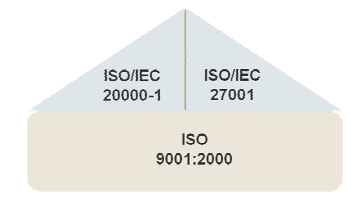 | Figure 1. Relation among ISO 9001, ISO 20000 and ISO 27001 [4] |
2. Research Methodology and Strategy
2.1. Research Classification
- The adopted strategy to reach the proposed objective is the single case analysis, classified as applied research regarding its nature, because it generates knowledge from the practical application to specific problems [8].The approach is classified as qualitative in the data collection, analysis and implementation, for being descriptive and both the process and its significance are the main focus of the approach [8].In relation to the procedure methods, this research uses action-research when conceived and performed in close association with an action or with the solution of a collective problem. The researchers and participants that are representative to the situation or the problem are involved in a cooperative or participative way [8]. The documental research is also used in the files of the object of study and the single case study [9].
2.2. Methodological Research
- The researches with descriptions of the implementation of the NBR ISO/IEC 20000 standard are scarce especially because there are few companies dedicated to such certification. However, it is possible to verify descriptions about the implementation of other standards, such as the NBR ISO 9001.Paes, Hora and Valdiviezo [10] reported the certification process of a basic sanitation company, comparing quantity of Work Instructions and managerial information systems used.Walter [11] discusses the certification process of the same standard, but unlike the above mentioned authors, he does not directly report the benefits, but the process itself, indicating the paths taken, documents created and necessary trainings.
2.3. Technical Procedures
- In order to reach the research objective, a documental research is performed in the company, seeking the descriptions of the implementation. The use of action-research, where the researcher is part of the object of study, allows the authors to report their perceptions regarding the implementation process, because they played an active role during the research.The results are analyzed both critically and qualitatively, indicating the critical points of the process so to support future implementations.
2.4. Results Analysis
- The reports obtained though action-research are critically analyzed in order to evidence the imperfections in the implementation and elaborate a directing text with the most critical points of the implementation process.
3. IT Services Management
- The implementation of IT services management, NBR ISO/IEC 20000-1, requires knowledge in both data processing and management. For that, the best IT Governances practices are used, such as ITIL and COBIT.
3.1. IT Governance Practices
- According to ISACA [12], the IT Governance is a structure of relationships and process to direct and control the company in order to reach its objectives by value addition at the same time as it balances risks and incomes regarding IT and its processes.There are many models or patterns which contribute to the IT Governance available in the market to support the companies in the implementation process, among which there are COBIT (Control Objectives for Information and Related Technology) and ITIL (Information Technology Infrastructure Library) [13], [14].Figure 2 shows how COBIT and ITIL are divided in order to cover the whole IT Governance, being the former in the strategic and tactic levels of the organization and the latter in the operational level.
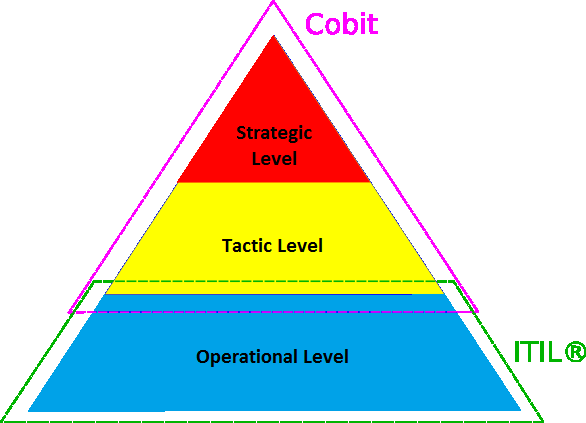 | Figure 2. COBIT and TI division to cover the whole IT Governance |
3.2. ITIL Practices
- ITIL was developed by CCTA (Central Computer and Telecommunication Agency), currently called OGC (Office of Government Commerce), in the United Kingdom, in the late 19880’s, being documented in a group of books which describe a reference model with the best practices for an effective IT Services Management. Even though it was originally conceived for the public sector in the United Kingdom, it rapidly expanded to the other organizations in the public and private sectors, generating an industry composed by trainings, certifications, consulting, software tools and a specific Forum called itSMF [15], [16].The ITIL seeks, in its methodology, the identification of processes in the IT area and the alignment of its services to the organization needs, promoting a qualitative approach for the economic, effective, effectual and efficient use of the IT infrastructure [14], [17].According to Shimada and Costa Jr. [18], the seven books which describe the library of best practices of ITIL are:• Service Support (Service Management) – Assures the client has access to appropriate services to support business functions. It comprehends Service Desk, Incidents Management, Problems Management, Configurations Management, Change Management and Release Management;• Service Provision (Service Management) – Covers the service the business demands the supplier to provide adequate support to the corporate users. Comprehends Capacity Management, Financial Management for IT Services, Availability Management, Service Level Management and Continuity Management;• Applications Management – Comprehends the life cycle of the software development, expending the superficially treated questions in support to the software life cycle and IT Services tests. Applications Management also gives details about changes in the business, emphasizing clear definitions of requirements and in the implementations of solutions to satisfy the needs of the business user;• IT Infrastructure and Telecommunications Management – Covers all the aspects from identifying the business requirements, through the proposal process, up to the test, the installation implementation and the continuous optimization of IT components and computers networks infrastructure and IT services;• Security Management – approaches Security from the services supplier’s point of view. Identifies and indicates the security level necessary to supply the organization with total service;• Planning to Implement the IT Services Management – Explains the steps needed for an organization to identify the benefits it can expect from ITIL and how to start collecting such benefits. It aids the organizations to identify their strong and weak points, thus reinforcing the former to overcome the latter;• Business Perspective – Offers counseling and orientation to help the Information Technology staff understand how they can contribute to the business objectives and how their functions and services can be better aligned and explored so to maximize this contribution.One of the main factors for the ITIL increasing success is its flexibility, because it should be implemented as part of a business methodology which involves the services management processes [19].
3.3. CobIT Practices
- According to Lahti and Peterson [13], CobiT is a guide to IT management recommended by ISACF (Information Systems Audit and Control Foundation, www.isaca.org). It includes resources such as executive summary, framework, objectives control, audit maps, group of implementation tools and guide with management techniques. The CobiT management practices are recommended by the IT management experts who help optimize the investments in IT and provide metrics to evaluate the results. CobiT does not depend on IT platforms adopted by the companies.According to Neves [20] the orientation to the processes is defined in 34 processes, divided in four domains, as described below [16]:• Plan and Organize (PO) – Approaches the strategies, tactics and aspects for a better contribution of IT to reach the business objectives;• Acquire and Implement (AI) – Approaches the IT strategies to identify solutions for IT, needs of development or technology acquisition, implementation and integration with the business processes;• Monitor and Evaluate (ME) – Approaches the performance management, internal controls monitoring and provides governance, aiming at evaluating the quality of the processes and the compliance with the control requirements.Acording to Lahti and Peterson [13], CobiT provides detailed information to manage processes based on business objectives. CobiT is projected to aid three distinct audiences:• Managers who need the risk and control the investments in IT in an organization;• Users who need guaranties that the IT services which depend on their products and services to internal and external clients are being managed;• Auditors who can stand on the CobiT recommendations to evaluate the IT management level and counsel the internal control of the organization.According to Neves [20], the business orientation tries to unite the business objectives and the IT objectives, supplying metrics and maturity models to better the IT governance evaluation, besides supporting the identification of responsibilities of the business and IT area. For that, it is needed to manage and control the IT resources by means of structured processes, such as audits, which enable delivering the goods/services according to the planning.
3.4. Management System Audits
- According to ABNT [21], audits are used to determine in which level the quality management system requirements are met. The audit findings are used to evaluate the efficacy of the quality management system and to identify improvement opportunities.First party audits are performed by the organization itself or on its behalf, for internal purposes, and may compose the basis for a self-declaration as for the conformity of the organization.Second party audits are performed by clients of the organization, or by other people on behalf of the client.Third party audits are performed by independent external organizations. Such organizations, usually accredited, provide certifications or registration of compliance with requirements such as those from ISO 9001 [22].NBR ISO 19011 provides guidelines regarding audits. Since the implementation of ISO 9001 in 2007 in the company CJHT, there has been a team capacitated for internal audits composed by representatives of the each area of the organization which executes this systematic every six months, alternating with the external audits. The Integrated Management System (IMS) staff, in partnership with all the other areas, performs all the planning, execution control and results treatment of the company standards.
3.5. ISO/IEC 20000
- According Polter, Verheijen and Selm [23], the ISO/IEC 20000 objective – inherited from BS 15000 – is to “provide a common pattern of reference to any company which offer IT services to internal or external clients”. Due to the importance of communication to the Services Management, one of the most important objectives of the standard is to create a terminology common to services providers, their suppliers and their clients. Figure 3 shows the coverage of ISO/IEC 20000 certification and its structure.
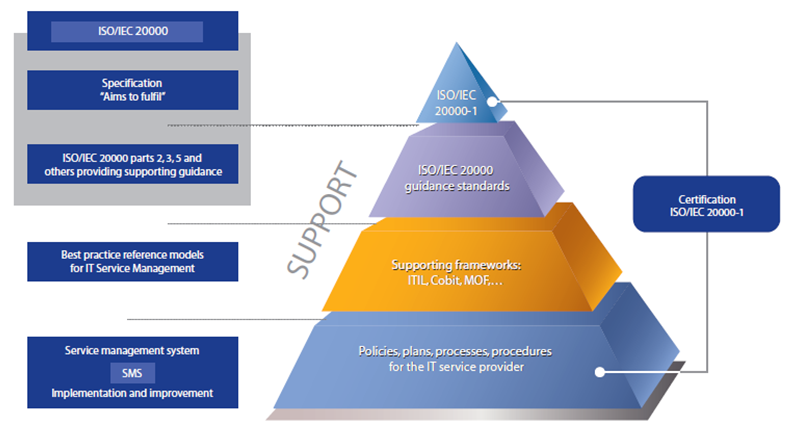 | Figure 3. ISO/IEC 20000 in the service management landscape [6] |
4. Object of Study Characterization
- The company CJHT of remote support in IT, located in Campos dos Goytacazes, in Rio de Janeiro state, is one of the largest Information Technology companies in Brazil, having differentials in the IT products and services provided to large corporations, as well as in the commercialization of equipment, softwares, supplies and accessories as a retailer to all customer audiences. This multiplicity of operations makes the IT remote support company known in the market as complete.The IT remote support company is 100% Brazilian, majorly acting in states of São Paulo, Rio de Janeiro and the Federal District in the IT Services areas, subdivided into: Infrastructure Management; Printing and Digital Content Solutions; Data Processing Point Outsourcing; WebCom; Systems Development and Maintenance; Projects Office (PMO); Partner Solutions; User Support and Customer Service; Printing Center divided into Offset, Laser, Finishing, Digital Color, among other products and services, besides the CJHT Digital.The Integrated Management System policy statement is made by the company president and it states that CJHT is a company which supplies the market with products, services and IT solutions, focusing on quality-directed client services. The IMS policy is also extended to the IT Services Management, focusing on information security and environment responsibility, taking into consideration the existing legislation and other environmental and continuous improvement aspects.The following objectives are extracted from the IMS Policy:• Increase the Company profitability;• Increase customers’ satisfaction – IT Services;• Implement the Integrated Management System in the whole Company;• Rationalize the use of natural resources by the Company;• Assure the recycling of residues generated by the processes covered by the environmental scope;• Promote the collaborators development;• Increase the Company collaborators’ satisfaction;• Keep the availability of a technological environment for the Company;• Assure the compliance of the levels of services hired and/or agreed upon;• Assure the non-occurrence of information security incidents.The measurement of the objectives listed above is performed through performance indicators and followed-up on a periodic basis.
5. Implementation Process
5.1. Environment
- The main motivation for the implementation and consequent certification in the IT Services Management is given by the demand on the contract renewal with the unique client in the segment of the company CJHT.The other motivations are:• Search for better practices in the market;• Greater participation in restrict market niche;• Increase the quality and the reliability in services provision;• Improve the management of contracts with suppliers and partners.
5.2. Preparation
- Once the certification is decided for, the managerial group carries out a meeting to define the implementation strategy of the due standard, as described by Figure 4.The ISO/IEC 20000 implementation process was performed in fourteen months, with high investment, and consisted of:• Define and approve the scope: a standard and certification scope of work is initially defined and submitted for prior approval by the certifying organization; the hiring of a external consulting with experience in implementation of standards is needed, as well as organizing a project coordination committee, composed by one member from each area (Operations, Quality, IT Solutions, Integrated Management System, Administrative / Procurement and Human Resources). The team is defined by the managerial body according to the profile of each member. There is a periodic videoconference between the consultant and the project coordination committee (locally and at the CJHT headquarters in Brasília) for the implementation of the next steps of the process.• Elaborate and approve project plan: a plan is create by the committee aided by the hired consulting and approved by the areas managers of CJHT;
 | Figure 4. Services Management Process [1] |
 | Figure 5. ISO/IEC 20000 implementation process |
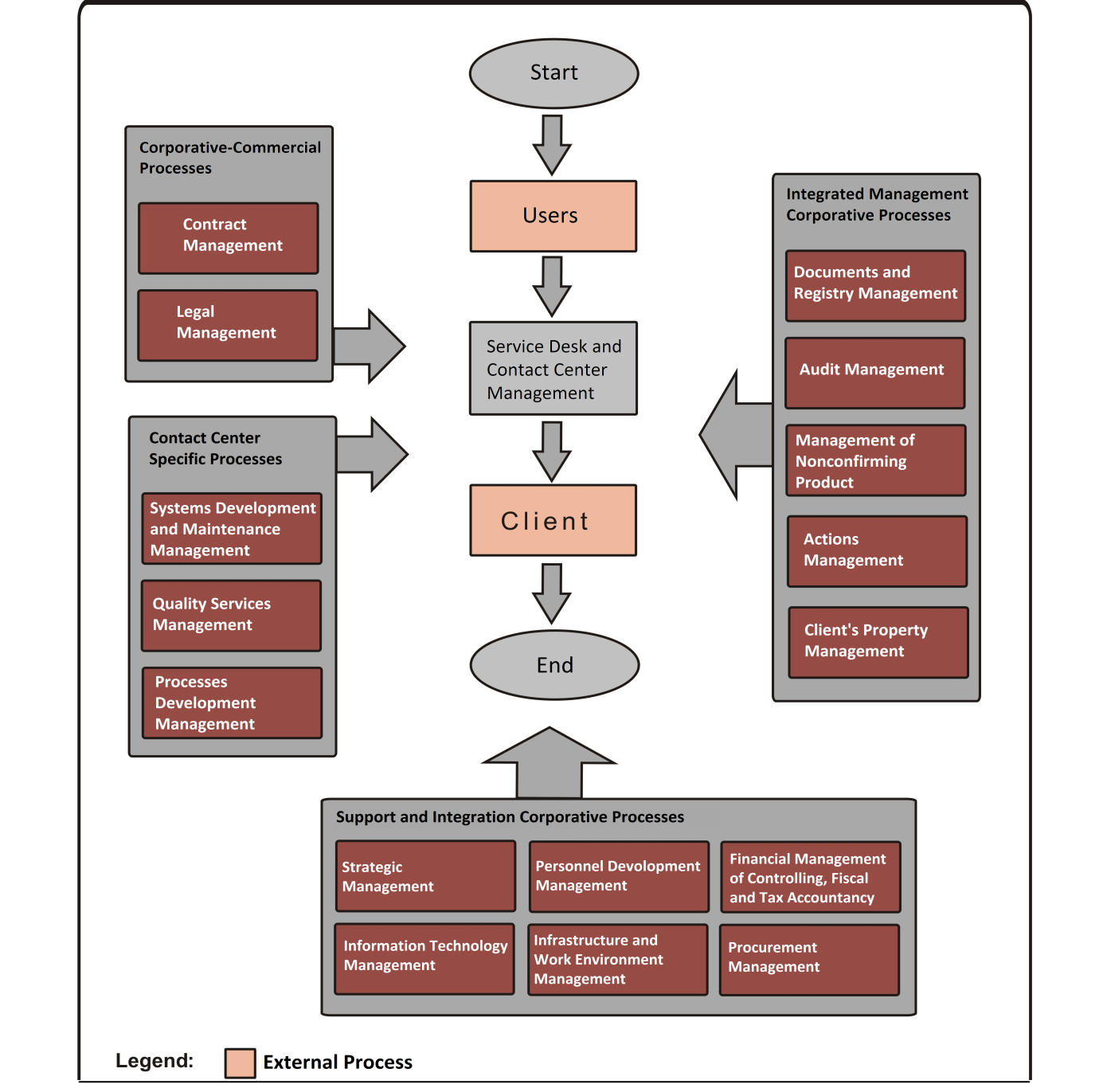 | Figure 6. Internal processes structure |
 | Figure 7. Implementation Timetable. Source: Internal Documentation from company |
5.3. Processes
- Work focused on processes is constituted by the four premises below:• Planning: Study the contract with the client and elaborate the Services Management Plan – SMP – including the implementation of the service management; issuance of service management processes; processes changes and new services. • The collaborators which perform activities in service management are capacitated based on education, training, skills and experience;• Implementation: Follows what is defined in the SMP regarding incidents and problems management; changes and release management; management of availability, capacity, continuity and configuration and continuous quality;• Service Provision: This process regards the definition, the agreements, the records and the services levels management;• Measurement and Monitoring: The performance compared to defined goals for service, client’s satisfaction, resources capacity use, tendencies and greater nonconformities are all monitored, measured and critically analyzed.The focus on the processes was used when implementing the NBR ISO/IEC 20000, so it is believed the IT services management was performed in a thorough way.
6. Conclusions
6.1. Concerning the Objectives
- The general objective of the research is reached through the elaboration of a detailed certification process, with all the implementation items detailed and accomplished.The specific objectives are met the following way:• Definition of research methodology and strategy, classifying it as action-research;• Description of IT Management Services and its integration with the IT Governance, COBIT and ITIL, besides the NBR ISO 9001 and 27002 standards;• Mentioning the systematic of integrated management system audits;• Description of the object of case study;• Mentioning the implementation process of the NBR ISO 9001:2008;• Performing the critical analysis of the listed bibliographic references.This way, it is possible to conclude that all the objectives were reached with the execution of this present research.
6.2. Concerning the Research
- Managing the IT services became a critical task and a challenge for managers, once it is responsible for 60% to 90% of the total costs of its ownership [7]. This research presented an entire documented certification process in the ISO 20000, and contributed to the scientific communication being an important reference for future similar processes for comparisons.According to Heldman [25], the lessons learned are the information collected and documented during the project which may be used for the benefit of the current project, future projects or any projects which may be under execution by the organization. Such lessons may be either positive or negative. During a project, knowledge should be transferred, integrated, created and explored in order to create new organizational value. This way, to obtain a ISO/IEC 20000 certification, collect information and meetings of the lessons learned were performed during all the project phases. The main results obtained after the implementation of the IT services management in the company CJHT were:• Benefits for the organization:− Provide managed services to satisfy the business and the client, at a reasonable cost;− Solve problems of continuity, availability, capacity of services supplied;− Provide tools to comply with the level of hired services;− Keep the Company competitive edge in the market;− Keep current and future contracts with the client.• Benefits for the collaborators− Work in a company which performs activities based on orientations and standards for services provision accepted worldwide;− Acquire professional growth practices in the Company.• Difficulties encountered− Interpretation of the NBR ISO 9001:2008 to implement the requirements, even after the training given on such standard;− Physical distance of the consultant, being him in Brasília, causing the meetings to be help through video-conference;− Conciliation of the ordinary activities and the activities of standard implementation, by the 20000 committee;− Need of customization of the bought tool, Qualitor Web, to adequate it to the company business;− Focus on the infrastructure area, causing considerable changes in the work routine and thus resistance.Thusly, the organization understands that the IT services management must be used to assure the service provision in the best possible way.The costs from the implementation of such standard and its consequent certification are high in comparison to the obtained results, because the client did not consider it as a requirement, but as a bonus, in his next order, once the other competitors had not implemented such standard in the organizations.In the case of the company being studies, the use of action-research was attempted due to the direct participation of the authors in the project and academic studies. The objective of the action-research was to solve a problem and contribute to the academic area with the research. The main relevance of this research was to establish a reference model for the ISO/IEC 20000 implementation and certification. The reference presented here has a prescriptive characteristic, being available to be used by any provider which wishes to initiate a project of this caliber. It was also attempted to present the results and lessons learned in a clear way, serving as base for future studies about the subject.
6.3. Concerning Future Researches
- This present research allows new analysis in various aspects to be implemented, such as:• Analyze qualitative and quantitative benefits in a mid to long term from the implementation of the standard;• Elaborate a market study evidencing the effect of the certification on the companies which got certified;• Elaborate a management model to aid the certification maintenance;• Analyze the requirements for implementing the ISO 9001, 20000 and 27002, evidencing the common grounds and how to simplify the parallel maintenance of such certifications, complying with all of their requirements.In general, it is suggested that the subject be researched upon after implementation so to open a quite vast range of possibilities which shall serve as initial idea to numerous further researches.
ACKNOWLEDGEMENTS
- The authors are grateful to the Fluminense Federal Institute, for supporting the research, and to the Company, for allowing the employees sharing its cultural knowledgement to the science progress.
Appendix
- Internal documents of company CJHT:
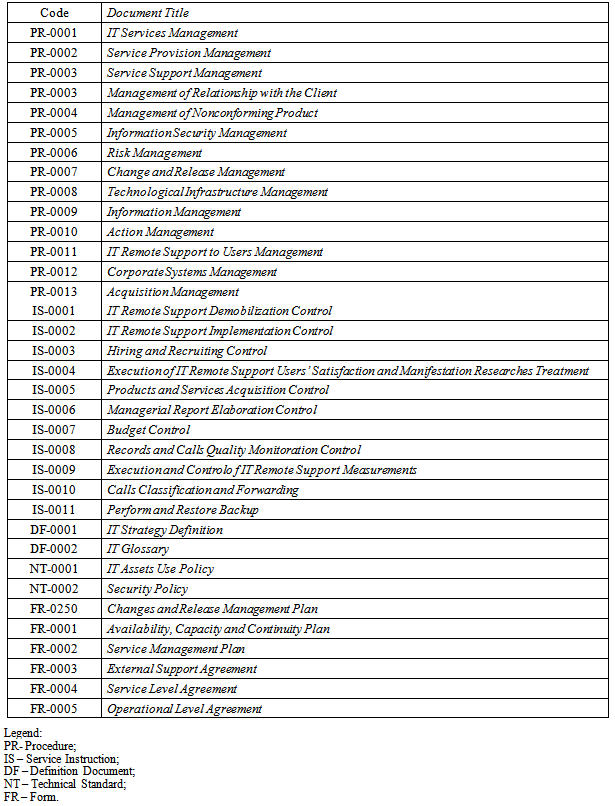
 Abstract
Abstract Reference
Reference Full-Text PDF
Full-Text PDF Full-text HTML
Full-text HTML